#mtDna
Text


Afro-Jamaicans are Jamaicans of predominant African descent. They represent the largest ethnic group in the country.
The ethnogenesis of the African Jamaican people stemmed from the Atlantic slave trade of the 16th century, when enslaved Africans were transported as slaves to Jamaica and other parts of the Americas. During the period of British rule, slaves brought into Jamaica were primarily Akan, some of whom ran away and joined with Maroons and even took over as leaders
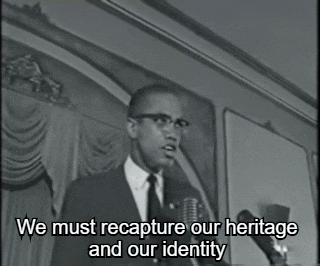
West Africans were enslaved in wars with other West African states and kidnapped by either African or European slavers. The most common means of enslaving an African was through abduction.

Based on slave ship records, enslaved Africans mostly came from the Akan people (notably those of the Asante Kotoko alliance of the 1720's: Asante, Bono, Wassa, Nzema and Ahanta) followed by Kongo people, Fon people, Ewe people, and to a lesser degree: Yoruba, Ibibio people and Igbo people. Akan (then called Coromantee) culture was the dominant African culture in Jamaica.
Originally in earlier British colonization, the island before the 1750s was in fact mainly Akan imported. However, between 1663 and 1700, only six per cent of slave ships to Jamaica listed their origin as the Gold Coast, while between 1700 and 1720 that figure went up to 27 per cent. The number of Akan slaves arriving in Jamaica from Kormantin ports only increased in the early 18th century. But due to frequent rebellions from the then known "Coromantee" that often joined the slave rebellion group known as the Jamaican Maroons, other groups were sent to Jamaica. The Akan population was still maintained, since they were the preference of British planters in Jamaica because they were "better workers", according to these planters. According to the Slave Voyages Archives, though the Igbo had the highest importation numbers, they were only imported to Montego Bay and St. Ann's Bay ports, while the Akan (mainly Gold Coast) were more dispersed across the island and were a majority imported to seven of 14 of the island's ports (each parish has one port).

Myal and Revival
Kumfu (from the word Akom the name of the Akan spiritual system) was documented as Myal and originally only found in books, while the term Kumfu is still used by Jamaican Maroons. The priest of Kumfu was called a Kumfu-man. In 18th-century Jamaica, only Akan gods were worshipped by Akan as well as by other enslaved Africans. The Akan god of creation, Nyankopong was given praise but not worshipped directly. They poured libation to Asase Ya, the goddess of the earth. But nowadays they are only observed by the Maroons who preserved a lot of the culture of 1700s Jamaica.
"Myal" or Kumfu evolved into Revival, a syncretic Christian sect. Kumfu followers gravitated to the American Revival of 1800 Seventh Day Adventist movement because it observed Saturday as god's day of rest. This was a shared aboriginal belief of the Akan people as this too was the day that the Akan god, Nyame, rested after creating the earth. Jamaicans that were aware of their Ashanti past while wanting to keep hidden, mixed their Kumfu spirituality with the American Adventists to create Jamaican Revival in 1860. Revival has two sects: 60 order (or Zion Revival, the order of the heavens) and 61 order (or Pocomania, the order of the earth). 60 order worships God and spirits of air or the heavens on a Saturday and considers itself to be the more "clean" sect. 61 order more deals with spirits of the earth. This division of Kumfu clearly shows the dichotomy of Nyame and Asase Yaa's relationship, Nyame representing air and has his 60 order'; Asase Yaa having her 61 order of the earth. Also the Ashanti funerary/war colours: red and black have the same meaning in Revival of vengeance. Other Ashanti elements include the use of swords and rings as means to guard the spirit from spiritual attack. The Asantehene, like the Mother Woman of Revival, has special two swords used to protect himself from witchcraft called an Akrafena or soul sword and a Bosomfena or spirit sword

Jamaican Patois, known locally as Patwa, is an English creole language spoken primarily in Jamaica and the Jamaican diaspora. It is not to be confused with Jamaican English nor with the Rastafarian use of English. The language developed in the 17th century, when enslaved peoples from West and Central Africa blended their dialect and terms with the learned vernacular and dialectal forms of English spoken: British Englishes (including significant exposure to Scottish English) and Hiberno English. Jamaican Patwa is a post-creole speech continuum (a linguistic continuum) meaning that the variety of the language closest to the lexifier language (the acrolect) cannot be distinguished systematically from intermediate varieties (collectively referred to as the mesolect) nor even from the most divergent rural varieties (collectively referred to as the basilect). Jamaicans themselves usually refer to their use of English as patwa, a term without a precise linguistic definition.
Jamaican Patois contains many loanwords of African origin, a majority of those etymologically from Gold Coast region (particularly of the Asante-Twi dialect of the Akan language of Ghana).
Most Jamaican proverbs are of Asante people, while some included other African proverbs

Jamaican mtDNA
A DNA test study submitted to BMC Medicine in 2012 states that "....despite the historical evidence that an overwhelming majority of slaves were sent from the Bight of Biafra and West-central Africa near the end of the British slave trade, the mtDNA haplogroup profile of modern Jamaicans show a greater affinity with groups found in the present-day Gold Coast region Ghana....this is because Africans arriving from the Gold Coast may have thus found the acclimatization and acculturation process less stressful because of cultural and linguistic commonalities, leading ultimately to a greater chance of survivorship and a greater number of progeny."
More detailed results stated: "Using haplogroup distributions to calculate parental population contribution, the largest admixture coefficient was associated with the Gold Coast(0.477 ± 0.12 or 59.7% of the Jamaican population with a 2.7 chance of Pygmy and Sahelian mixture), suggesting that the people from this region may have been consistently prolific throughout the slave era on Jamaica. The diminutive admixture coefficients associated with the Bight of Biafra and West-central Africa (0.064 ± 0.05 and 0.089 ± 0.05, respectively) is striking considering the massive influx of individuals from these areas in the waning years of the British Slave trade. When excluding the pygmy groups, the contribution from the Bight of Biafra and West-central rise to their highest levels (0.095 ± 0.08 and 0.109 ± 0.06, respectively), though still far from a major contribution. When admixture coefficients were calculated by assessing shared haplotypes, the Gold Coast also had the largest contribution, though much less striking at 0.196, with a 95% confidence interval of 0.189 to 0.203. When haplotypes are allowed to differ by one base pair, the Jamaican matriline shows the greatest affinity with the Bight of Benin, though both Bight of Biafra and West-central Africa remain underrepresented. The results of the admixture analysis suggest the mtDNA haplogroup profile distribution of Jamaica more closely resembles that of aggregated populations from the modern-day Gold Coast region despite an increasing influx of individuals from both the Bight of Biafra and West-central Africa during the final years of trading enslaved Africans.
The aforementioned results apply to subjects whom have been tested. Results also stated that African Jamaicans (that make up more than 90% of the population) on an average have 97.5% of African MtDNA and very little European or Asian ancestry could be found. Both ethnic and racial genetic results are based on a low sample of 390 Jamaican persons and limited regional representation within Jamaica. As Afro-Jamaicans are not genetically homogeneous, the results for other subjects may yield different results.

#african#afrakan#kemetic dreams#africans#brownskin#brown skin#afrakans#african culture#afrakan spirituality#asante#jamaican#benin#bight of biafra#gold coast#mtdna#afro jamaicans#twi#west africa#africa#algeria#uganda#ethiopia#ghana#myal#rastafari#rasta#rastaman#rasta love#kisumi amau#tegan and sara
119 notes
·
View notes
Text


On the images: on the left a migration path of mtDNA H1af2 - the mtDNA of Alexandra Feodorovna maternal line; on the right the region in France where the earliest mtDNA ancestor of Alexandra Feodorovna originated from.
What is known about the mtDNA of Alexandra Feodorovna (Alix of Hesse)?
The mtDNA of Alexandra Feodorovna: H1af2 (source FBI Laboratory - 2018)
The earliest known ancestor: Alba Autun (846-?)- France
The year of formation of the mtDNA: 100 BCE
Number of descendants: 11 (the ones who took mtDNA test with FTDNA)
Current location of the descendants: France, Switzerland, and Germany
#investigation#research#romanovs#seraphima bogomolova#mtDNA#Alexandra Feodorovna#ancestry#Alix of Hesse
2 notes
·
View notes
Link
RESEARCH ARTICLE:
Museum specimens of a landlocked pinniped reveal recent loss of genetic diversity and unexpected population connections
University of Oulu
#Yle.fi#Ecology and Evolution#Suomi#Finland#Oulun Yliopisto#University of Oulu#research#Itäsuomi#Itä-Suomi#East Finland#Saimaa#Lake Saimaa#Saimaan norppa#Saimaa Ringed Seal#Pusa hispida saimensis#Phoca hispida saimensis#Genetiikka#Genetics#DNA#mtDNA#dna sequencing#suomitumblr#suomitumppu#suomi tumppu#suomi tumblr#suomijutut
5 notes
·
View notes
Photo
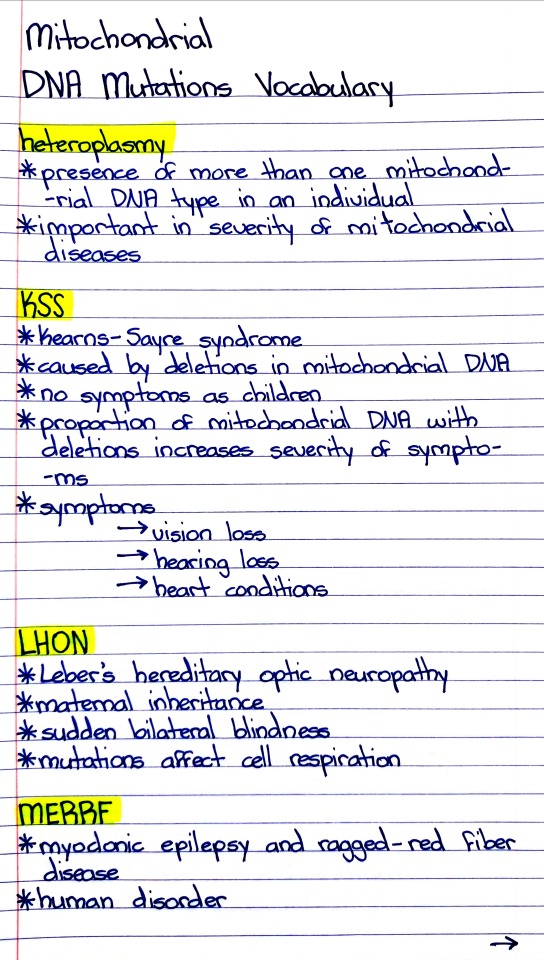
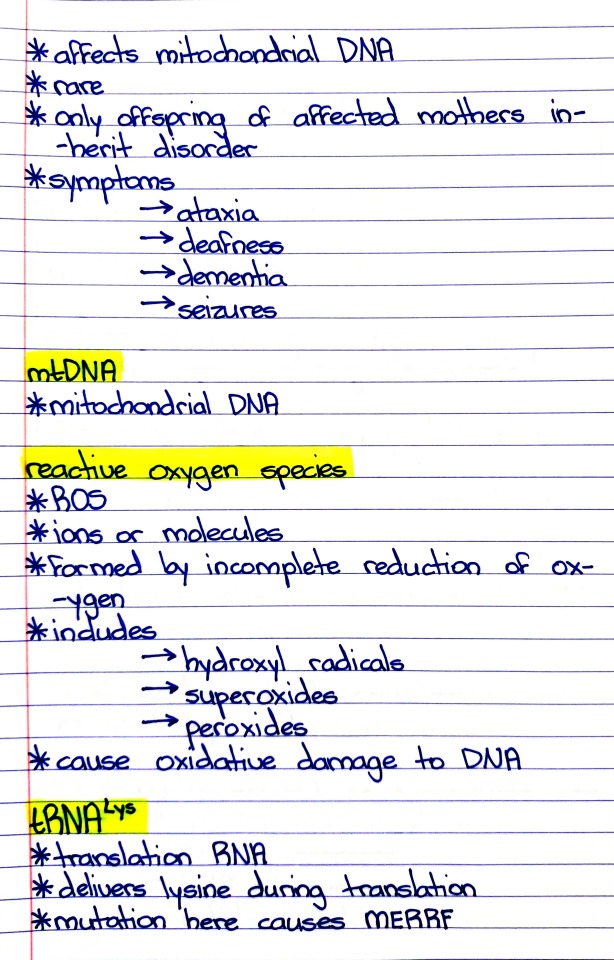
#studyblr#notes#medblr#medical notes#med notes#mtdna#trna#rna#rna notes#dna#dna notes#genetics#genetics notes#translation rna#translation rna notes#mitochondria#mitochondrial mutation#mitochondrial mutations#mitochondrial dna#mitochondrial dna notes#peroxides#superoxides#reactive oxygen species
3 notes
·
View notes
Text
youtube
The Origin of Maternal Mitochondrial Haplogroup J: From Fertile Crescent to Modern Day
Learn about the pivotal role of Maternal Haplogroup J, which traces back to a common female ancestor in the Near East, a region also referred as the fertile crescent, and its significant contribution to early agriculture and civilization.
Explore the two subclades, J1 and J2, their geographical distribution, and how they unlock secrets of ancient human migrations and cultural exchanges. From the Fertile Crescent to ancient Greece and Rome, uncover the historical significance of these genetic markers in shaping our shared human history.
#OriginOfMaternalHaplogroupJ#MaternalHaplogroupJ#MaternalMitochondrialHaplogroupJ#MaternalLineage#mtDNA#AncientCivilizations#HumanHistory#Genetics#Ancestry#Mesopotamia#GeneticsAncesty#GeneticHeritage#History#FertileCrescent#Agriculture#CradleOfCivilization#HumanMigration#Civilization#Greece#Rome#GeneticDiversity#NeolithicRevolution#UpperPaleolithicEra#Youtube
0 notes
Text
New Book
I've been working upon a new book. My second book. I've been connecting the Spanish side of my Genealogy for years now. During that process I kept coming up on, indigenous ancestors. I thought it's high time I begin writing about my journey of discovery. The title of the book:
Discovering my Guanahatabey and Taino Indigenous ancestors. From Coamo to San German Puerto Rico. It's still in process.
#Guanahatabey#Taino#ancient history#Puerto Rico#Enslaved#San German Militia Indios roster#John Browne Ayés author.#Genealogy#Biogenealogy#Genome#DNA#MtDNA#indigeneity#Discovery
0 notes
Text
DNA Analyses
Several studies [1-2; see also 3] have examined mitochondrial DNA (mtDNA) collected from wolves, coyotes, and suspected hybrids throughout North America. Lehman et al. (1991) have determined that repeated (at least six) mating events between wolves and coyotes have led to the introgression of coyote mtDNA genotypes into wolf populations. No wolf genotypes were found in sampled coyotes, indicating a unidirectional introgression from coyotes to wolves [1]. The integrity of mtDNA haplotypes suggests that either (1) interbreeding between female wolves and male coyotes is not prevalent or (2) the resulting offspring of this type of cross do not breed further. Because viable hybrid offspring may have crossbred back into the coyote population rather than the wolf, some coyote populations may have greater genetic contributions from male wolves than can be determined through mtDNA analyses [1].
More recent studies [3-4] have determined that the genetic composition of these hybrids—coywolves—is approximately 60-65% coyote, 25-30% wolf, and 10% dog. In a study published in 2010 [4], geneticists discovered that DNA samples grouped in the Northeast yet remained distinct from their parental species’ genes [see also 3, 5], which indicates that coywolves are "currently breeding true…and now have relatively little influence from their parent species in the core of their range" [3, p. 46]. These overall genetic determinations have led to disagreement over whether coywolves should be considered their own species (i.e., Canis oriens) [6; see also 7].
References:
[1] Lehman, N., Eisenhawer, A., Hansen, K., Mech, L.D., Peterson, R.O., Gogan, P.JP., & Wayne, R.K. (1991). Introgression of coyote mitochondrial DNA into sympatric North American gray wolf populations. Evolution, 45(1), 104–119. https://doi.org/10.2307/2409486
[2] Stronen, A.V., Tessier, N., Jolicoeur, H., Paquet, P.C., Hénault, M., Villemure, M., … Lapointe, FJ. (2012). Canid hybridization: Contemporary evolution in human-modified landscapes. Ecology and Evolution, 2(9), 2128-2140. https://doi.org/10.1002/ece3.335
[3] Way, J.G. (2021). Coywolf: Eastern coyote genetics, ecology, management, and politics. Eastern Coyote/Coywolf Research, Barnstable, Massachusetts. www.easterncoyoteresearch.com/Coywolf/
[4] Way, J.G., Rutledge, L., Wheeldon, T., & White, B.N. (2010). Genetic characterization of eastern “coyotes” in Eastern Massachusetts. Northeastern Naturalist, 17(2), 189-204. easterncoyoteresearch.com/downloads/GeneticsOfEasternCoywolfFinalInPrint.pdf
[5] Way, J.G. & Lynn, W.S. (2016). Synthesis - Northeastern coyote/coywolf taxonomy and admixture: A meta-analysis. Canid Biology & Conservation, 1-7. canids.org/CBC/19/Northeastern_coyote_taxonomy.pdf
[6] Way, J.G. (2016, May 11). Why the eastern coyote should be a separate species: the ‘coywolf.’ The Conversation US. https://theconversation.com/why-the-eastern-coyote-should-be-a-separate-species-the-coywolf-59214
[7] Rutherford, S. (2018). The Anthropocene’s animal? Coywolves as feral cotravelers. Environment and Planning E: Nature and Space, 1(1-2), 206-223. https://doi.org/10.1177/2514848618763250
TL;DR:
Wolves and coyotes have interbred, creating viable offspring called "eastern coyotes" or "coywolves"
The average coywolf's genetic makeup is approx. 60% coyote, 30% wolf, and 10% dog, with influence from parental species' genes currently little to none
There is disagreement over whether coywolves should be considered a separate species
Hybridization | Range & Diet | Behavior & Ecology | Attitudes | Conservation | The Anthropocene
#coywolf#northeastern coyote#eastern coyote#canis latrans var.#canis latrans x canis lycaon#western coyote#eastern wolf#canis latrans#canis lycaon#alternative senior thesis project#hybridization#introgression#mtdna#canis oriens#anthropology#ecology
0 notes
Text
Hidden in plain sight: cryptic insect species.

View On WordPress
0 notes
Text
sorry don't mind me writing a fucking essay in the tags i'm putting off my evolution studies by thinking about evolution.
0 notes
Text
youtube
Watch how Africans populated the earth. Also pay attention to that route out of North East Africa.
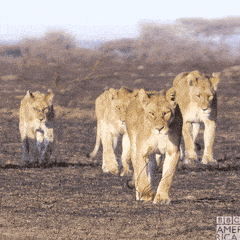
#medna#mtdna#human migration#africa#east africa#african#afrakan#kemetic dreams#afrakans#brown skin#brownskin#africans#middle east#south africa#dna#dnangelic#dna activation#dnaedit#dna test#science#sciencenature#scientists#world#cells#social science#social spirit#social security#social software#social skills#asia
15 notes
·
View notes
Link
#yellow cockatiel bird male or female#white cockatiel bird male or female#what is Single Nucleotide Polymorphism#what is RFLP#what is mtDNA#what is Mitochondrial DNA#what is NGS#what is Restriction Fragment Length Polymorphism#what is Polymerase Chain Reaction#what is Microsatellite analysis#what is DNA Microarrays#What is DNA Testing for Birds#what is Fluorescence in situ hybridization#what is DNA-DNA hybridization#what is DNA Barcoding#what is Chromosome painting#Species Identification#The Reliable Solution For Bird Gender Identification#Vocal Cues#TiktokParrot#Polymerase Chain Reaction in birds#parrot bird male or female#parrot Gender Determination#peach faced lovebird male or female#parrots Genetic disease screening#parrot Vocal Cues#parakeet bird male or female#love birds male female difference#love birds male female identification#male bird vs female
0 notes
Text
I've got a kind-of crack theory about Ruby's mother...
Back in The Church on Ruby Road, Ruby is invited onto Long Lost Family, a genealogy TV program hosted by Davina McCall, with the hope of finding some information about her bio family. Unfortunately, they come up with nothing.






[ID: 6 gifs showing Ruby and Davina McCall talking to each other on the phone from The Church on Ruby Road. Davina apologies to Ruby, who tries to hide her upset at the news.
DAVINA: "There is no trace of your mum or dad. I'm sorry. It happens sometimes."
RUBY: "No, that's fine... Thanks but, um, could you keep looking?"
DAVINA: "No, there's nothing more we can do. If your parents aren't on some kind of database, we can't find them."
RUBY: "Ok, um... isn't that unusual though? There's not a single trace anywhere? I mean... in the whole wide world, my mother's never left a blood sample or anythin'?"]
Now obviously, I know tracking down family is hard and, especially for orphans and adopted children, there's no gurantee that you'll be able to get the information you need. But I do find it odd there's seemingly "no trace" of Ruby's parents.
The section where I go on an odd tangent about genealogy
Speaking as someone who isn't a genealogist, but does enjoy researching family history in what little spare time they have... in my experience, close DNA matches aren't that hard to find. Especially if you're of white european descent, as Ruby is (presumably).
(It's generally harder for other ethnicities, as most research resources are white english/american focused. I know this is especially tricky for people like african-americans, where many of one's ancestors may have been enslaved. I've personally also found it tricky with Jewish communities as historically many of them used patronymic names prior to the 1800s, plus you have to account for immigration name changes, pogroms etc.)
For example, as someone who is white, with a mix of various british, mainland european, and ashkenazi ancestors, I actually have thousands of DNA matches, just from an autosomal test on Ancestry alone, let alone something like an mtDNA, xDNA or yDNA test:
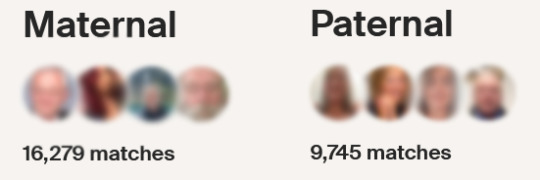
[ID: Edited screenshot showing maternal and paternal DNA matches on my AncestryDNA profile. There are 16279 maternal matches and 9745 paternal matches.]
Obviously, due to the way family trees work, most of these are distant matches, however it does include plenty of close ones too, which I've been able to trace to real records and identify relationships with. Personally, my matches even already include many 1st and 2nd cousins, albeit usually a one or two degrees removed, especially as the userbase tends to swing older on these websites. This includes a few people close enough for me to have already known them from family functions and shared annecdotes. Meanwhile, where I did have blank spots, from immigrations, estranged family members, early deaths etc, I've been able to fill in a lot of information.
So what does it mean that there's "no trace" of Ruby's family?
Deliberate or not?
The big question I've had since The Church on Ruby Road is: just how untraceable is Ruby's family?
On one hand, I feel like if this was real life and professional TV genealogists were helping you, you'd get a bit more information than a quick phone call saying they've got zilch. If they're sharing nothing... do they literally have nothing?
On the other hand, this also feels like a writing shortcut. We don't really need 3 hours of Davina McCall sat with Ruby at a computer breaking down every question and theory about possible family members. Ultimately, this was probably just a way to quickly get some major exposition out there, plus throw in a Christmas celebrity cameo for casual viewers. The fact they only talk about Ruby's "parents" being in a DNA database, and no-one else, doesn't give me a lot of faith in the care for accuracy RTD took with this plot point tbh.
Indeed Davina does say 'it happens sometimes', which could indicate it's not as extreme as having zero close relatives...
...but Ruby also asks if it's unusual for there to be no trace of anything, which Davina doesn't answer. If we're asking that question, it sounds like things really could have turned up that blank.
It may not be easy for orphans and adoptees to find family, but I assume it must be quite rare to have zero possible leads? Especially if you're a younger person, and thus may have a good number of people of the right generation to know/remember your family members still alive. Worst case scenario, I can imagine having some leads, only for someone to be uncontactable, or lack the information that would be useful. That being said, maybe I'm being too optimistic, as someone who had the priviledge of never having as much difficulty.
The weird sci-fi parallel (TW: incest (kinda), intersexism)
This is where we get to my theorising. Because in a science fiction context, and specifically a time-travel one, there is one quite famous short story that has a protagonist with zero family connections: '—All You Zombies—' by Robert A Heinlein.
(Fun fact: "All You Zombies" is also the name of a planned Class Ongoing story, once I get the time to resume that.)
You may also be familiar with the movie adaptation: 'Predestination'. It's also seemingly the inspiration for all sorts of similar stories, from 'The Man Who Folded Himself' to Red Dwarf and Futurama.
You might see where i'm going from that last one...
(Again disclaimer: if you seek it out, that this story may be quite triggering. It also was written in 1959. While it's actually somewhat respectable of a trans (kind-of, you'll see what I mean - I'll generally use the pronouns used in the text below) protagonist, it includes sexism, intersexism bordering on medical horror, and selfcest/incest.)
In 1963 (funnily enough), a lonely, orphaned 18 year old woman named Jane has a sexual encounter with a man in a park which ends up leaving her pregnant. When complications arise, the doctor discovers during a successful caesarian she's actually intersex, with a form of ovotesticular syndrome, with her immature, partially developed organs "a mess". He removes the now damaged womb, ovaries etc and, without consent, 'rearranged things so that [they] can develop properly as a man".
A few weeks later, the baby is stolen from the hospital by a man.
Despite all this tragedy, they do decide to complete their transition, restarting life as a man. He struggles to find work, but eventually finds himself making a living selling fake confession stories to magazines as "the Unmarried Mother".
Years later In a bar, he tells his story to a Bartender. After it all, the Bartender reveals he's actually a time agent and offers the chance to see his baby's father again. He drops him off in 1963 to find the man.
Meanwhile, in 1964, the Bartender steals a baby from a hospital, and drops her off at an orphanage in 1945.
The Bartender returns to the Unmarried Mother a month later in 1963, just in time to see him leaving a lonely young woman he met with in a park...
"Now you know who he is", the Bartender says, "—and after you think it over you’ll know who you are... and if you think hard enough, you’ll figure out who the baby is... and who I am.” He drops the Unmarried Mother off in 1983, where he can be recruited by the Temporal Bureau.
The Bartender, Jane, the Unmarried Mother, the kidnapper, the Father, and the Baby are revealed to all be one person, a family tree onto themself. The perfect time agent, causally disconnected from the rest of humanity and thus safe from Faction Paradox - if they are truly human at all (possibly explaining their biological bi-sexuality).
Thus, literally, having no relatives.
NO, OF COURSE I don't think this is what's up with Ruby!
But...
A lot of people have suggested that the woman who drops off Ruby could be herself. Obviously this doesn't necessarily mean Ruby is her own mother - let alone her own intersex father, child, and recruiter too!
But the story did come to my mind watching the Christmas special, and I do think the less squicky side of it, the 'perfect time agent' angle is worth considering. Could Ruby really be causally/genetically disconnected from the rest of humanity? Could she literally have no close relatives?
Assuming her DNA is not taken from any other person, but some semi-random mix of genes, she really may not match with anyone. At most, she would have some distant false matches, who share very small portions of DNA with her just by statistical fluke.
"BUT", I hear you say, "Didn't she get rewritten by the literal butterfly effect in episode one? She must be connected to humanity!"
Yes she did. But you know else happened?
She was still there.
Seriously think about it. Time travel fiction often doesn't think about the full consequences of time being altered even slightly, especially for a gag, but think about it literally. If all of human history was changed and a whole new species, possibly descended from Silurians, became dominant on the planet...
... why would the Doctor still happen to be travelling with someone with a name beginning with 'Rub-' who looks like Millie Gibson? Remember her name comes from Ruby Road... so does 'Ruby Road' exist on Rubathon's Earth? The Church presumably doesn't, unless there's a lizard Jesus...
At the very least we can point to the Web of Time being particularly reinforced around Ruby for some reason, even after all the damage it's taken between Flux and now, letting Ruby persist into the new timeline. This is explicitly confirmed in the last episode, with the Doctor calling it a fixed point.
At worst, it may imply whatever 'designed' Ruby just needs her to meet the Doctor, no matter what the dominant species on Earth is.
Mind you, both of these do open questions about what happened in the timeline where Ruby was eaten by the Goblin King. Maybe targetting her after her birth left her temporally vulnerable? Or maybe it was a necessary event, to bring the Doctor to Ruby Road...
Add this to some other things we've seen this season:
In Space Babies, we're introduced to the concept of 'baby farms', allowing people to be loomed born without a parent.
We also know, at least, that Ruby registers as human to the TARDIS (though given Sutekh's influence, who knows how trustworthy that scan was now!).
In The Devil's Chord, Ruby is not erased by Maestro destroying humanity. Granted we can put this down to the Doctor/TARDIS, and how time travel effects people's biodata, but I think it could be a misdirect.
(Interestingly there was a very similar plotpoint in "City of the Daleks", the Eleventh Doctor adventure game, which saw the New Dalek Paradigm invading Earth in...1963. Unlike Ruby, Amy eventually actually does start to fade, needing a 'chronon blocker' to stabilise her. Hey remember how we just heard the word 'chronon' used a bunch in the show.)
In Boom, the Ambulance is entirely unable to find a next of kin for Ruby, despite seemingly having her in its records. This is a little hard to dissect, as you could take a lot of different interpretations away from it. At the very least, it suggests Ruby doesn't have any living descendents in the 51st century. Carla probably doesn't either (which makes sense with her not having any bio-kids, and Ruby seemingly being the only child she fully adopted rather than fostered?) But for its extensive records, it's notable it still couldn't find anyone after that, even presumably with access to Ruby's DNA like the genealogists had.
Everything in 73 Yards.
Between the snow falling in each episode, plus context in The Legend of Ruby Sunday, we know that Christmas Eve on Ruby Road, while fixed, is also uniquely vulnerable and 'raw'. With the woman's changing reactions to the Doctor, it's also flexible enough to change, somewhat.
Similarly, the possible connection between the woman who dropped Ruby off and the woman in 73 Yards, between her face not being visible and the CCTV camera being around 73 yards / 66.6 metres away. And if that woman really was Ruby, then maybe the parallels to All You Zombies may not be as insane as they sound.
#Doctor Who#DW Spoilers#Doctor Who Spoilers#Ruby Sunday#The Legend of Ruby Sunday#All You Zombies#DW Theory#DW Meta#long post
93 notes
·
View notes
Text
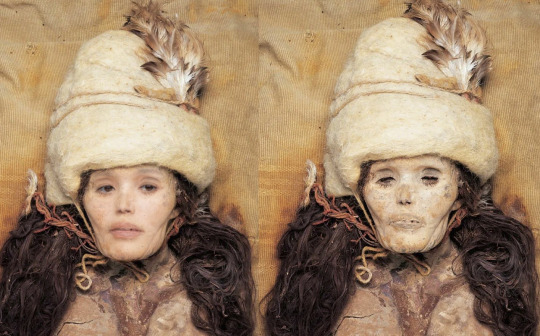
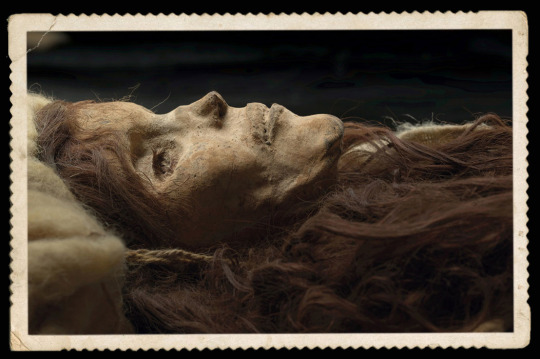
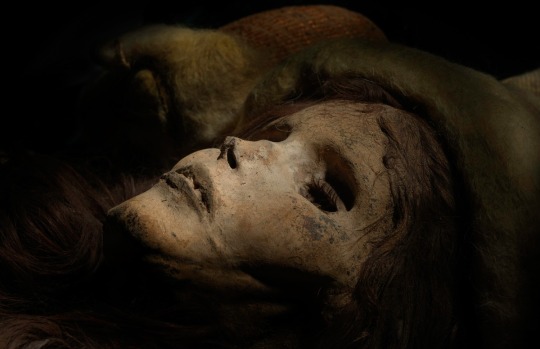



The Beauty of Xiaohe mummy (aka Little River Princess) ca. 1800–1500 BCE. Reconstruction of her face in first pic by TheHolyMountain on Reddit.
"The Tarim Basin, located on the ancient Silk Road, played a very important role in the history of human migration and cultural communications between the West and the East. However, both the exact period at which the relevant events occurred and the origins of the people in the area remain very obscure. In this paper, we present data from the analyses of both Y chromosomal and mitochondrial DNA (mtDNA) derived from human remains excavated from the Xiaohe cemetery, the oldest archeological site with human remains discovered in the Tarim Basin thus far.
Mitochondrial DNA analysis showed that the Xiaohe people carried both the East Eurasian haplogroup (C) and the West Eurasian haplogroups (H and K), whereas Y chromosomal DNA analysis revealed only the West Eurasian haplogroup R1a1a in the male individuals.
Our results demonstrated that the Xiaohe people were an admixture from populations originating from both the West and the East, implying that the Tarim Basin had been occupied by an admixed population since the early Bronze Age. To our knowledge, this is the earliest genetic evidence of an admixed population settled in the Tarim Basin.
The Tarim Basin in western China, positioned at a critical site on the ancient Silk Road, has played a significant role in the history of human migration, cultural developments and communications between the East and the West. It became famous due to the discovery of many well-preserved mummies within the area. These mummies, especially the prehistoric Bronze Age 'Caucasoid' mummies, such as the 'Beauty of Loulan', have attracted extensive interest among scientists regarding who were these people and where did they come from.
Based on analyses of human remains and other archaeological materials from the ancient cemeteries (dated from approximately the Bronze Age to the Iron Age), there is now widespread acceptance that the first residents of the Tarim Basin came from the West. This was followed, in stages, by the arrival of Eastern people following the Han Dynasty."
-Evidence that a West-East admixed population lived in the Tarim Basin as early as the early Bronze Age, by Chunxiang Li, et al.
172 notes
·
View notes
Text
I'm in such a weird position when it comes to "science will solve your disability" because while I'm okay with less people being born with mitochondrial flaws and changing someone's mtDNA doesn't change who they are, it just changes their energy generation abilities so it's not considered eugenics, it won't help anyone who's already been born and it's impossible to treat beyond supportive care.
Technology is also making my life actively better now by working WITH my disabled body as well. I have a powerchair that allows me to cook and garden and I have a ventilator that helps me breathe and that's okay with me.
So I guess I'm of the opinion that genetic "cures" are a good idea for mitochondrial disease specifically BUT we also need to keep working on supportive care and making people's lives better that way too.
#eugenics talk#dont ask me about other genetic diseases like Downs syndrome because i dont have them#and refer to THEIR feelings about their own genetic diseases instead
49 notes
·
View notes
Photo
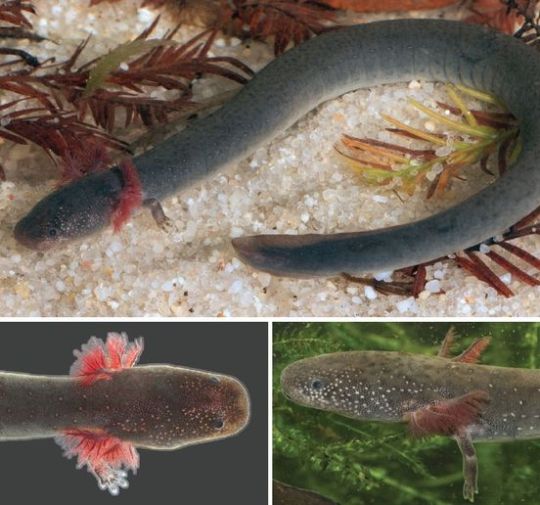
BIG NEWS IN SALAMANDER TAXONOMY!
Unraveling Siren (Caudata: Sirenidae) systematics and description of a small, seepage specialist
Fedler, Enge, and Moler
Abstract
For approximately four decades, scientists have known of the existence of several undescribed species of Siren in the southeastern United States Coastal Plain.
One of these species, S. reticulata, was recently described, but a small, seepage-dwelling species has remained undescribed until now.
To resolve outstanding questions concerning the phylogeny of Siren, we collected sequence and morphometric data from specimens across the range of Siren.
We found S. lacertina and S. reticulata to represent strongly supported monophyletic groups, with S. reticulata having a sister relationship to all other Siren. Additionally, we found five distinct mtDNA lineages within what has been recognized as S. intermedia. Siren lacertina and type-locality S. intermedia (lineage A) are sister mtDNA lineages, whereas S. intermedia lineages B and C show a high level of mitogenomic divergence from type-locality S. intermedia.
Analyses of two scnDNA loci revealed that S. lacertina is monophyletic but nested with low positional support in a clade including the three S. intermedia mtDNA lineages. Further study is needed to determine whether S. intermedia lineages A, B, and C represent distinct species or incompletely sorted lineages.
We restrict the range of S. intermedia to the region from the Escambia and Perdido river drainages of Florida and Alabama eastward through Virginia (the combined ranges of lineages A, B, and C).
We also elevate S. i. nettingi (lineage E) to species status and include the larger S. i. texana form in that taxon, generating a species that occurs from the Mobile Bay drainages westward through the Mississippi Basin and southwest into northeastern Mexico.
Lastly, we describe a new miniature species, S. sphagnicola, that ranges from the Florida Parishes of Louisiana eastward to the westernmost tributary creeks of Choctawhatchee Bay in the western Florida panhandle.
Read more here:
https://mapress.com/zt/article/view/zootaxa.5258.4.1
223 notes
·
View notes